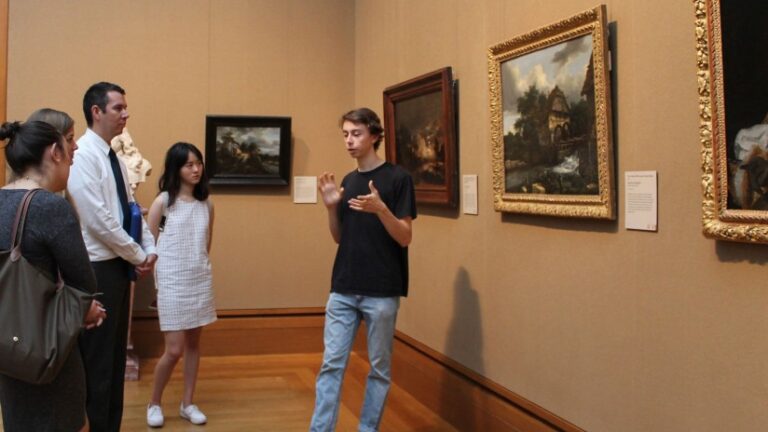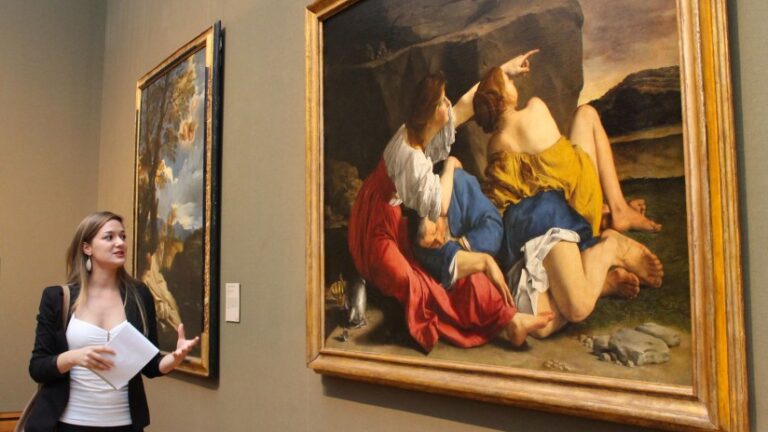Students connect with artists and their art at Getty Museum
Art History at USC
The Art History undergraduate curriculum is designed to give majors enough flexibility to develop their own area of study. In addition to taking additional courses in any given area for the Distribution Requirement, students are also encouraged to carry out directed research projects under the supervision of one faculty member. This can be arranged to coincide with a trip overseas or as a part of a pre-approved Study Abroad program in which the student has the opportunity to study artifacts and monuments in-situ. By working closely with a faculty member in this way, students are well-prepared to become an independent researcher who can explore any given topic in a systematic, meaningful way. In fact, the students who take the initiative to carry out directed research often choose to enroll in graduate programs after college to pursue their intellectual interests.
-
Art History courses at USC consider a variety of objects from different historical periods, places and cultures in relation to their makers, patrons, viewers and critics. Majors are exposed to a diversity of theoretical approaches and encouraged to sharpen their critical and conceptual thinking skills. Many Art History majors decide to pursue a graduate degree in Art History, either in museum studies or in a particular historical field within the discipline. The Department of Art History faculty at USC maintains strong ties with local and national institutions, thereby enhancing its ability to place departmental majors wishing to pursue a career in a museum, auction house, art gallery, or other arts organizations. Art History graduates are well prepared for jobs in public relations, entertainment, education, journalism, publishing, business, and law. Note: a grade of “C” or higher is required for all undergraduate Art History majors in all AHIS courses counted toward major requirements.
-
Art History combines the study of art with the study of culture broadly conceived. The Art History minor offers a concentrated course of study that includes a variety of objects from different historical periods and cultures in relation to their makers, patrons, viewers and critics. Students in the minor are trained to analyze visual images and information through a process of intensive looking, reading, research and writing.
-
The Modern Art Markets and Ethics minor is designed for students, including Art History majors, who are drawn to an interdisciplinary study of modern art markets. The minor allows students to consider the intersection of law, ethics, and cultural studies. It offers students an interdisciplinary education in art institutions, and ethical discourses that surround the production, display, circulation, and consumption of art, both past and present. The minor will help students develop the critical skills of reading, writing and analysis crucial to a liberal education. Students will gain theoretical and analytical perspectives on ethical, political, and social issues relevant to art as they explore how the market informs and shapes our encounter with artistic objects.
-
(Art History and other participating units: Architecture, Cinematic Arts, Communications, English, Comparative Literature, Fine Arts, Philosophy)
More than ever, students of today need the critical skills and intellectual breadth required to describe, analyze, and evaluate visual culture. Visual Culture encompasses fine art, film and television, photography and video illustrated books, advertising, architecture and design. A critical approach to Art History provides both the foundation and departing point for this interdisciplinary minor. Students are required to take two introductory courses in the history and theory of art which will prepare them for a focused study in one of three concentrations: (1) Photography, film and the reproduction of images; (2) Popular culture; or (3) Gender and sexuality.
The minor is open to all undergraduate majors and is especially relevant for those whose fields employ visual images to convey ideas as well as information. The minor will complement pre-professional majors (such as those in film) as well as in the humanities and social sciences.
-
A special feature of the undergraduate program is the apprenticeship, which affords upper-division students the opportunity to work in the professional art world in return for academic credit. Students gain valuable job skills in local museums, galleries, auction houses, and art foundations.
Apprenticeships usually last one semester and carry two academic units. Semester-long apprenticeships require a minimum of 10 hours of supervised work in an art-related institution each week for the 15 weeks of the semester. In addition, the student must attend class meetings to discuss apprenticeship and career issues. Apprenticeship placement for the summer is also available at institutions throughout the United States. Local participating institutions range from large museums, such as the Los Angeles County Museum of Art and the Museum of Contemporary Art, to small independent galleries in and around the city.
For more information, send email to the AHIS Director of Undergraduate Studies, Professor Lisa Pon, lisapon@usc.edu
-
Research and writing of original thesis under guidance of faculty member. For more information, send email to the AHIS Director of Undergraduate Studies, Professor Lisa Pon, lisapon@usc.edu.
-
Students that study abroad gain a special perspective on the world beyond their own borders, which will benefit them throughout the rest of their lives. Studying abroad for a semester or year is one of the best ways to understand a different culture in a meaningful way. It is an experience that can have a profound impact on a student academically, personally, and professionally. USC College and the Art History Department encourages students to consider including studying abroad in their undergraduate experience.
To further explore overseas studies, please visit the following website: http://www.college.usc.edu//overseas-studies/
-
USC Schedule of Classes Art History
For D-Clearance requests, send email to the Undergraduate Student Advisor, Brianna Nicole Beltran, bnbeltra@usc.edu.
-
Since its founding in 1880, USC has grown into a top-tier private research institution, with all the resources of a large, urban university and the nurturing environment of a small liberal arts college. Students thrive in interdisciplinary, learner-centered curricula that uniquely prepare them to face the challenges of the 21st century.
Whether your passion is art or anthropology, computer science or the life sciences, you will have opportunities to explore, to challenge and to distinguish yourself.
Learn more about our university at the About USC website.




